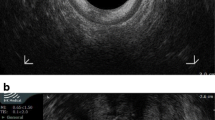Abstract
PURPOSE: The aim of this study was to determine whether special investigations significantly alter either the diagnosis or the management plan of patients with fecal incontinence assessed on the basis of a structured history and physical examination alone. METHODS: Fifty consecutive patients with fecal incontinence were prospectively studied in a tertiary referral clinic. Each patient was assessed by two clinicians who independently formulated a diagnosis and treatment plan based on the history and physical examination. The resulting 100 patient assessments were then compared with the final diagnosis and treatment plan formulated on completion of endoanal ultrasound, anal manometry, external sphincter electromyography, and defecating proctography. RESULTS: In the assessment of fecal incontinence, the addition of special investigations altered the diagnosis of the cause of incontinence based on history and examination alone in 19 percent of cases. The management plan was altered in 16 percent of cases. Special investigations were most useful in separating neuropathy from rectal wall disorders and in demonstrating the unexpected presence of internal sphincter defects and neuropathy. CONCLUSIONS: Even experienced colorectal surgeons will misdiagnose up to one-fifth of patients presenting with fecal incontinence if assessment is based on the history and physical examination alone. However surgically correctable causes of incontinence are rarely missed on clinical assessment.
Similar content being viewed by others
References
Thomas TM, Egan M, Walgrove A, Meade TW. The prevalence of fecal and double incontinence. Community Med 1984;6:216–20.
Mandelstam DA. Fecal incontinence: social and economic factors. In: Henry MM, Swash M, eds. Coloproctology and the pelvic floor: pathophysiology and management. London: Butterworths, 1985:217–22.
Fink RL, Roberts LJ, Scott M. The role of manometry, electromyography and radiology in the assessment of fecal incontinence. Aust N Z J Surg 1992;62:951–8.
Carty N, Moran B, Johnson CD. Anorectal physiology measurements are of no value in clinical practice: true or false? Ann R Coll Surg Engl 1994;76:276–80.
Hallan RI, Marzouk DE, Waldron DJ, Womack NR, Williams NS. Comparison of digital and manometric assessment of anal sphincteric function. Br J Surg 1989;76:973–5.
Madoff RD, Williams JG, Caushaj PF. Fecal incontinence. N Engl J Med 1992;326:1002–7.
Swash M, Snooks SJ. Electromyography in pelvic floor disorders. In: Henry MM, Swash M, eds. Coloproctology and the pelvic floor. London: Butterworths, 1985:88–103.
Varma JS, Smith AN. Anorectal profilometry with the microtransducer. Br J Surg 1984;71:867–9.
Cali RL, Blatchford GJ, Perry RE, Pitsch RM, Thorson AG, Christensen MA. Normal variation in anorectal manometry. Dis Colon Rectum 1992;35:1161–4.
Sultan AH, Kamm MA, Talbot IC, Nicholls RJ, Bartram CI. Anal endosonography for identifying external sphincter defects confirmed histologically. Br J Surg 1994;81:463–5.
Tjandra JT, Milsom JW, Schroeder T, Fazio VW. Endoluminal ultrasound is preferable to electromyography in mapping anal sphincteric defects. Dis Colon Rectum 1993;36:689–92.
Rogers J, Laurberg S, Misiewicz JJ, Henry MM, Swash M. Anorectal physiology validated: a repeatability study of the motor and sensory tests of anorectal function. Br J Surg 1989;76:607–9.
Neill ME, Swash M. Increased motor unit fibre density in the external anal sphincter muscle in ano-rectal incontinence: a single fibre EMG study. J Neurol Neurosurg Psychiatry 1980;43:343–7.
Rogers J, Henry MM, Misiewicz JJ. Combined sensory and motor deficit in primary neuropathic fecal incontinence. Gut 1988;29:5–9.
Hentz VR. Construction of a rectal sphincter using the origin of the gluteus maximus muscle. Plast Reconstr Surg 1982;70:82–5.
Williams NS, Patel J, George BD, Hallan RI, Watkins ES. Development of an electrically stimulated neoanal sphincter. Lancet 1991;338:1166–9.
Felt-Bersma RJ, Klinkenberg-Knol EC, Meuwissen SG. Investigation of anoretal function. Br J Surg 1988;75:53–5.
Laurberg S, Swash M, Henry MM. Delayed external sphincter repair for obstetric tear. Br J Surg 198;75:786–8.
Mahieu P, Pringot J, Bodart P. Defecography. II. Contribution to the diagnosis of defecation disorders Gastrointest Radiol 1984;9:253–61.
Author information
Authors and Affiliations
Additional information
Read at the New Zealand Annual Scientific Meeting of The Royal Australasian College of Surgeons, Wellington, New Zealand, August 20 to 23, 1996.
About this article
Cite this article
Keating, J.P., Stewart, P.J., Eyers, A.A. et al. Are special investigations of value in the management of patients with fecal incontinence?. Dis Colon Rectum 40, 896–901 (1997). https://doi.org/10.1007/BF02051195
Issue Date:
DOI: https://doi.org/10.1007/BF02051195




